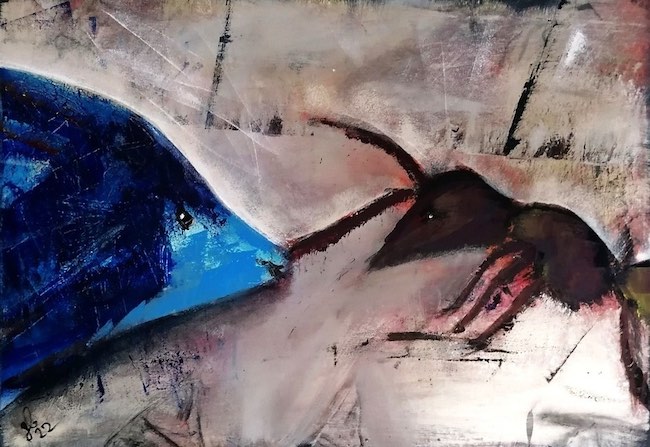Nell’arte contemporanea la possibilità di mescolare e di generare una sintesi tra linguaggi del passato spesso persino dissonanti alle loro origini, costituisce una possibilità in più per i creativi di dar vita a una cifra stilistica più conforme al proprio personale sentire, a un punto di vista che non riuscirebbe ad appartenere né completamente all’una né all’altra parte; alla luce di questo tipo di libertà interpretativa gli artisti trovano la forza di affrancarsi da ogni schema e di essere semplicemente se stessi senza limitazioni e soprattutto esprimendo in pieno tutto ciò che la loro natura suggerisce o verso cui li dirige. La protagonista di oggi racchiude nella sua pittura due stili apparentemente inconciliabili eppure, in questo caso, perfettamente armonici e in grado di rappresentare un mondo fatto di osservazione dei piccoli dettagli che hanno catturato la sua attenzione e che in virtù del suo sguardo visionario si spostano in una dimensione diversa, assumendo significati inaspettati.
Il mondo dell’interiorità è stata a lungo esclusa da tutta l’espressione artistica perché le linee guida accademiche, che avevano dominato l’arte fino alla metà del Diciannovesimo secolo, puntavano a riprodurre la realtà basandosi prevalentemente sull’equilibrio estetico, la perfezione cromatica e la cura dei dettagli attraverso cui poter creare l’immagine più affine a ciò che l’occhio era abituato a osservare; verso la fine del secolo tuttavia, cominciò a emergere un’irrequietezza, un’insofferenza nei confronti di quelle rigide regole che sfociò in una vera e propria ribellione, una presa di distanza netta e totale verso un modo di fare arte non più al passo con i cambiamenti dei tempi. In Francia il gruppo dei Fauves scelse un approccio completamente innovativo alla pittura, che consisteva nell’utilizzo di colori accesi e intensi, bestiali appunto, per raccontare una realtà puramente legata alla soggettività dell’autore dell’opera, piena delle emozioni e delle interiorizzazioni che pur di fuoriuscire liberamente potevano rinunciare alla bellezza, all’armonia, alla prospettiva e alle proporzioni, perché ciò che doveva emergere era solo la sensazione. Da quelle teorie iniziali, che mai si concretizzarono in un vero e proprio movimento, nacque un’importante evoluzione che si diffuse e declinò le sue linee guida sulla base del paese di provenienza degli artisti che vi aderirono; l’Espressionismo, questo il nome del movimento, ebbe nei paesi del nord Europa una particolare diffusione, sia perché soprattutto in Germania vi furono due grandi gruppi artistici, il Die Brücke e il Der Blaue Reiter che diffusero e svilupparono le tematiche Fauves adattandole a uno stile più moderato eppure in grado di travolgere l’osservatore sia perché il carattere più chiuso e introspettivo di quei popoli, e di conseguenza degli artisti, riusciva a trovare in questo stile pittorico il perfetto canale comunicativo. E ancora, il mondo interiore fu centrale anche nella ricerca artistica del Surrealismo, altro movimento nato gli inizi del Novecento, dove però i maestri come Salvador Dalì, Yves Tanguy e Max Ernst si focalizzarono sull’inconscio, sulla dimensione onirica, visionaria, inquieta a volte persino terrificante di tutto ciò di cui la mente non riusciva a prendere coscienza mentre nella loro arte poteva emergere senza alcun filtro; lo stile esecutivo dei surrealisti rispettava i canoni tradizionali della profondità, delle proporzioni, della gamma cromatica attinente alla realtà, tuttavia stravolgeva completamente ogni certezza visiva conducendo l’osservatore in un mondo immaginario, dove ogni riferimento veniva di fatto sovvertito. L’artista tedesca Gundel Busch unisce questi due mondi stilistici, l’Espressionismo e il Surrealismo, per manifestare la sua visione su tutto ciò che le ruota intorno o che ha osservato durante un viaggio o una breve parentesi della sua esistenza, trasformando ogni frammento in un sogno, trasportando tutto in una dimensione parallela elaborata dalle sue sensazioni, dal suo bisogno e desiderio di mettere su tela quell’energia percettiva e introspettiva che la contraddistingue.
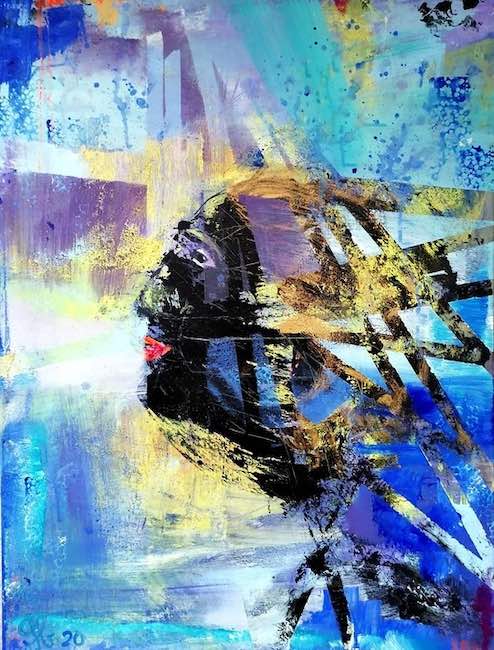
La libertà di espressione è simile a quella esistenziale che respira ogni giorno in virtù della sua scelta di vivere ai margini della Foresta Nera, un luogo magico dove la natura è regina incontrastata e dove la vita è priva di tutte quelle sollecitazioni, del logorio dovuto ai ritmi caotici delle grandi città, e dove la dimensione umana è quella su cui si focalizza la vera esistenza. Vivere in un ambiente tanto armonico induce Gundel Busch ad avere un approccio aperto verso tutto ciò che vede, e che attrae la sua attenzione fino al punto di diventare protagonista di un’opera, e anche a infondere nelle sue tele tutta la magia immaginativa che un luogo tanto incantato sicuramente stimola, pertanto l’Espressionismo, prevalentemente legato a emozioni e sensazioni reali e quotidiane, ha bisogno di tendere verso l’irrealtà del Surrealismo.
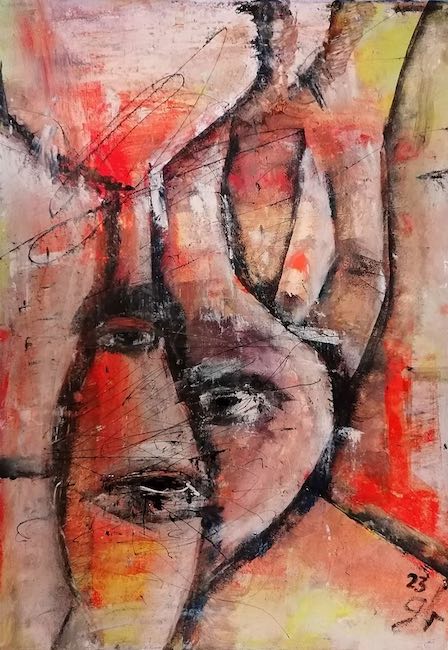
La decontestualizzazione, l’introduzione di elementi irreali quanto dominanti come gli occhi non legati alla presenza di un volto, la simbologia che avvolge alcune opere, sono tutti elementi che si amalgamano a uno stile pittorico privo delle regole prospettiche e coloristiche tradizionali, le figure principali spesso contornate da un bordo scuro oppure in alcuni casi sfumate quasi a perdersi nello sfondo. La sensazione che si riceve osservando le opere di Gundel Busch è di abbandono nei confronti di un sentire troppo spesso ignorato, di interazione con tutto ciò che apparentemente non avrebbe voce se non attraverso un ascolto profondo, sottile, e in connessione con le energie che circondano l’essere umano ma che possono essere percepite solo attraverso una particolare sensibilità.
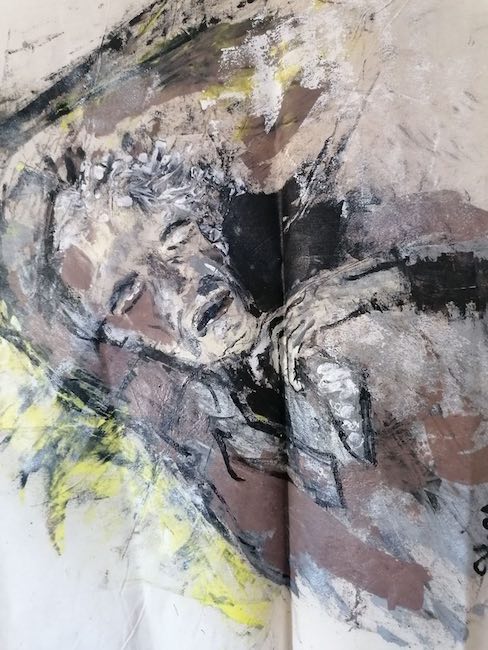
Ogni volta che affronta un tema, la Busch lo analizza da diverse angolazioni, lo ripete per estrapolare ciascun dettaglio, dando così vita a serie pittoriche in cui però ciascuna ha la sua singola vita, la sua specifica personalità; in Schlaf (Sonno) l’artista si interroga sull’esigenza umana di dedicare molto tempo della vita all’atto del dormire, visto come momento di rigenerazione, di necessità irrinunciabile per recuperare le forze per poi affrontare il giorno seguente. In quest’opera il protagonista è ritratto nel suo momento di massima incoscienza, di vulnerabilità proprio perché nel mondo onirico tutto assume una connotazione differente e ciò che emerge all’osservatore esterno, in questo caso a Gundel Busch, è quella totale inconsapevolezza del proprio corpo, della dimensione del tempo e dello spazio che sembrano comprimersi per il periodo in realtà lungo un’intera notte.
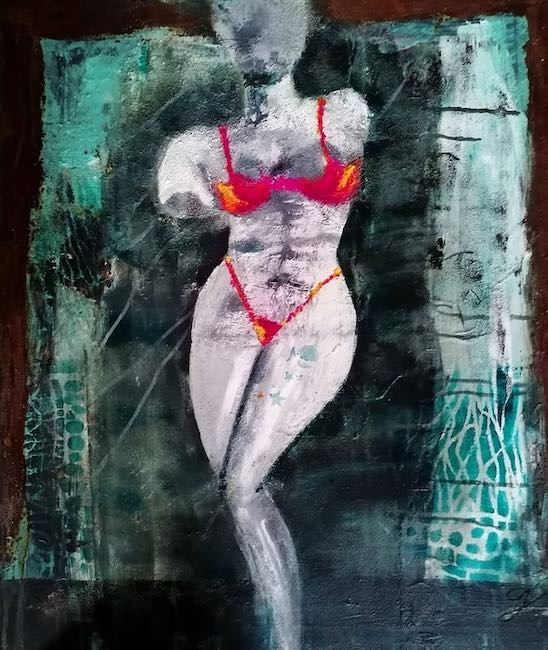
La tela In grün (In verde) invece appartiene alla memoria di un’estate trascorsa in Italia, in occasione di una mostra personale nella riviera romagnola, durante la quale è rimasta colpita dal rapporto delle donne italiane con il proprio corpo, con la spontaneità di esporlo a prescindere che risponda o meno ai canoni di bellezza imposti dalla società contemporanea, e dunque ha sentito lo stimolo a dedicare molte opere a questo tema. Qui la donna appare come un manichino, senza braccia e senza testa, come se Gundel Busch volesse sottolineare che non importa chi si sia, ciò che conta davvero è il coraggio di fare ciò che si vuole senza curarsi del giudizio esterno, e questo è un suggerimento per tutte le donne, il non dare peso ai modelli che l’esterno vorrebbe imporre bensì ricercare l’armonia con se stesse. Dunque da un lato l’Espressionismo tende verso l’emotività, dall’altro la decontestualizzazione del Surrealismo viene interpretato in modo completamente differente rispetto alla spersonalizzazione dei manichini Metafisici di Giorgio de Chirico, al contrario sono un invito ad andare oltre l’apparenza per concentrarsi sulla propria essenza.
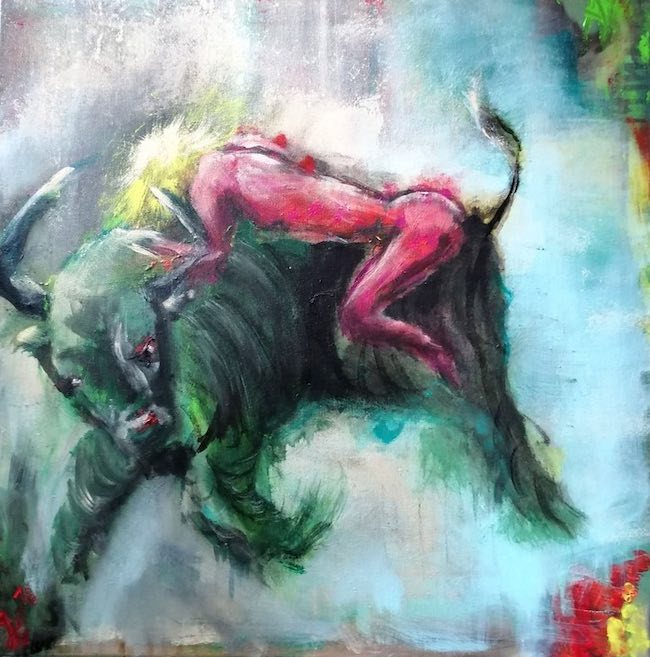
In Blindes Vertrauen (Fiducia cieca) appare ancora una volta un elemento improbabile nella realtà, quello di una donna che cavalca un toro, e quell’atto così inconsueto diviene protagonista della tela ma anche metafora di un desiderio dell’artista che si compia il miracolo dell’esistenza, quello in cui gli esseri umani non siano più una minaccia gli uni per gli altri e i più forti scelgano una strada nobile, quella cioè di diventare una protezione per chi è maggiormente debole, fragile; l’auspicio è che ciascun individuo possa trovare qualcuno a cui appoggiarsi esattamente nel momento in cui ne ha più bisogno, senza rischiare di essere traditi, ecco perché la donna sale sul dorso del toro che, in quel caso, non si imbizzarrisce, tutt’altro sembra invece ammansirsi in virtù del bisogno di protezione che emerge dalla posa del corpo della ragazza.

Gundel Busch utilizza il colore acrilico mescolandolo spesso con gesso, pastello, cera e ruggine, e una delle caratteristiche principali delle sue opere è la stratificazione della pittura, dei molti livelli con cui dà vita alle scene a metà tra realtà e visione e su cui talvolta agisce con un leggero grattage, quasi a voler sottolineare l’incisività del messaggio che desidera affidare alla figurazione.
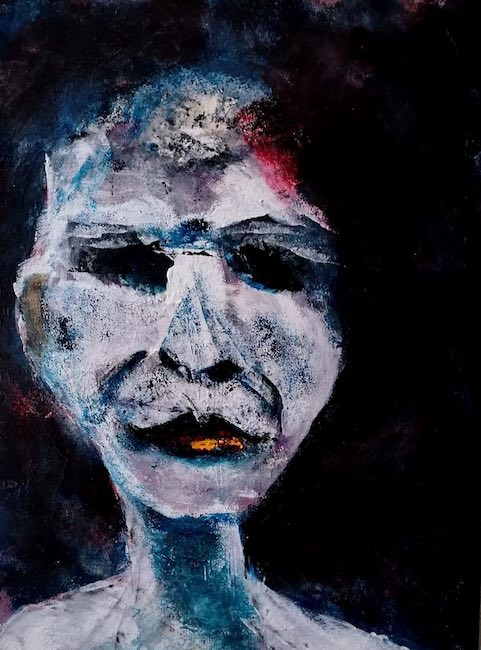
Gundel Busch ha al suo attivo la partecipazione a mostre collettive e personali ad Arbon, Basilea e Zurigo in Svizzera, Berlino, Bremen, Denzlingen, Emmendingen, Essen, Freiburg im Breisgau, in Germania, Roma e Venezia in Italia, Salisburgo e Vienna in Austria.
GUNDEL BUSCH-CONTATTI
Email: info@gundelbusch.art
Sito web: www.gundelbusch.art/
Facebook: www.facebook.com/gundel.busch.art
Instagram: www.instagram.com/gundelbusch/
The disruptive intensity of emotions in Gundel Busch’s Surrealist Expressionism, between visions and fragments of moments
In contemporary art, the possibility of mixing and generating a synthesis between languages of the past, often even dissonant to their origins, constitutes an additional possibility for creatives to give life to a stylistic figure more in line with their own personal feeling, to a point of view that would not be able to belong completely to one side or the other; in the light of this type of interpretative freedom, artists find the strength to free themselves from any scheme and to simply be themselves without limitations and above all expressing fully all that their nature suggests or towards which it directs them. Today’s protagonist encloses in her painting two styles that are apparently irreconcilable yet, in this case, perfectly harmonious and capable of representing a world made up of the observation of small details that have captured her attention and that, by virtue of her visionary gaze, move into a different dimension, taking on unexpected meanings.
The world of interiority was for a long time excluded from all artistic expression because the academic guidelines, which had dominated art until the mid-19th century, aimed to reproduce reality by relying mainly on aesthetic balance, chromatic perfection and attention to detail through which to create the image closest to what the eye was accustomed to observe; towards the end of the century, however, began tu emerge a restlessness, an intolerance of those rigid rules that resulted in a real rebellion, a clear and total detachment from a way of making art that was no longer in step with the changing times. In France, the Fauves group chose a completely innovative approach to painting, which consisted in the use of bright and intense colours, bestial in fact, to narrate a reality purely linked to the subjectivity of the author of the artwork, full of the emotions and internalisations that in order to escape freely could renounce beauty, harmony, perspective and proportions, because what had to emerge was only sensation. From those initial theories, which never materialised into a real movement, was born an important evolution that spread and declined its guidelines on the basis of the country of origin of the artists who adhered to it; Expressionism, this is the name of the movement, was particularly widespread in northern European countries, both because especially in Germany there were two great artistic groups, Die Brücke and Der Blaue Reiter, which spread and developed Fauves themes, adapting them to a more moderate style that was nevertheless able to overwhelm the observer, and because the more closed and introspective character of those peoples, and consequently of the artists, was able to find the perfect channel of communication in this style of painting.
And again, the inner world was also central to the artistic research of Surrealism, another movement born at the beginning of the 20th century, where, however, masters such as Salvador Dali, Yves Tanguy and Max Ernst focused on the unconscious, on the dreamlike, visionary, restless and sometimes even terrifying dimension of all that the mind could not become aware of, while in their art it could emerge without any filter; the execution style of the Surrealists respected the traditional canons of depth, proportions, and the colour palette pertinent to reality, yet completely upset every visual certainty by leading the observer into an imaginary world where every reference was in fact subverted. The German artist Gundel Busch combines these two stylistic worlds, Expressionism and Surrealism, to manifest her vision of everything that revolves around her or that she has observed during a journey or a brief parenthesis of her existence, transforming each fragment into a dream, transporting everything into a parallel dimension elaborated by her sensations, her need and desire to put on canvas that perceptive and introspective energy that distinguishes her. The freedom of expression is similar to the existential freedom she breathes every day by virtue of her choice to live on the edge of the Black Forest, a magical place where nature is undisputed queen and where life is free of all those stresses and strains, of the wear and tear caused by the chaotic rhythms of the big cities, and where the human dimension is what true existence is all about. Living in such a harmonious environment induces Gundel Busch to have an open approach to everything she sees, and which attracts her attention to the point of becoming the protagonist of an artwork, and also to infuse her canvases with all the imaginative magic that such an enchanted place surely stimulates, so that Expressionism, predominantly linked to real, everyday emotions and sensations, needs to tend towards the unreality of Surrealism. The decontextualisation, the introduction of elements as unreal as they are dominant such as the eyes not linked to the presence of a face, the symbolism that envelops some paintings, are all elements that amalgamate with a pictorial style devoid of traditional rules of perspective and colouring, the main figures often surrounded by a dark border or in some cases blurred almost to the point of being lost in the background. The sensation one receives when observing Gundel Busch‘s works is one of surrender to a feeling that is too often ignored, of interaction with everything that would seemingly have no voice except by listening deeply, subtly, and in connection with the energies that surround the human being but can only be perceived through a particular sensitivity.
Every time she tackles a theme, Busch analyses it from different angles, repeating it to extrapolate each detail, thus giving life to pictorial series in which, however, each one has its own individual life, its own specific personality; in Schlaf (Sleep) the artist questions the human need to dedicate much of life to the act of sleeping, seen as a moment of regeneration, an indispensable necessity to recover strength to then face the following day. In this painting, the protagonist is portrayed in his moment of maximum unconsciousness, of vulnerability, precisely because in the dream world everything takes on a different connotation, and what emerges to the outside observer, in this case to Gundel Busch, it is that total unawareness of one’s own body, of the dimension of time and space that seem to compress for the period that is actually a whole night long. The canvas In grün (In green) instead belongs to the memory of a summer spent in Italy, on the occasion of a personal exhibition on the Romagna Riviera, during which she was struck by the relationship of Italian women with their own bodies, with the spontaneity of expose it regardless of whether or not it responds to the canons of beauty imposed by contemporary society, and therefore she felt the urge to dedicate many artworks to this theme. Here, the woman appears as a mannequin, without arms and without a head, as if Gundel Busch wanted to emphasise that no matter who one is, what really counts is the courage to do what one wants without caring about external judgement, and this is a suggestion for all women, not to give weight to the models that the outside would like to impose but to seek harmony with oneself.
So on the one hand Expressionism tends towards emotionalism, on the other hand the decontextualisation of Surrealism is interpreted in a completely different way than the depersonalisation of Metaphisycal mannequins of Giorgio de Chirico, on the contrary they are an invitation to go beyond appearance to focus on one’s own essence. In Blindes Vertrauen (Blind Trust), once again appears an element that is improbable in reality, that of a woman riding a bull, and this unusual act becomes the protagonist of the canvas but also a metaphor for the artist’s desire for the miracle of existence to take place, in which human beings are no longer a threat to one another and the strongest choose a noble path, that of becoming a protection for those who are weaker, more fragile; the hope is that each individual can find someone to lean on exactly when he needs it most, without risking being betrayed, which is why the woman climbs onto the back of the bull, which, in that case, does not bolt, on the contrary, it seems to soften in virtue of the need for protection that emerges from the pose of the girl’s body. Gundel Busch uses acrylic paint, often mixing it with chalk, pastel, wax and rust, and one of the main characteristics of her artworks is the layering of the paint, of the many levels with which she gives life to scenes somewhere between reality and vision, and on which she sometimes acts with a slight grattage, almost as if to emphasise the incisiveness of the message she wishes to entrust to the figuration. Gundel Busch has participated in group and solo exhibitions in Arbon, Basel and Zurich in Switzerland, Berlin, Bremen, Denzlingen, Emmendingen, Essen and Freiburg im Breisgau in Germany, Rome and Venice in Italy, and Salzburg and Vienna in Austria.


